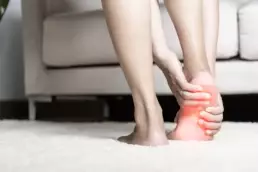“How long will cortisone shot last?” is a common question in our office. If you’re considering a cortisone shot for pain relief, you may be wondering how long you can expect the effects to last. The truth is, there is no “one-size-fits-all” answer to this question. How long a Cortisone shot lasts depends on several factors, including the specific problem being treated, the individual’s overall health, and how their body responds to the injection. This comprehensive guide will dive into the topic and provide all the information you need about the duration of relief from a cortisone shot. We’ll explore conditions commonly treated with cortisone shots, discuss potential benefits and risks, and provide insights into what you can expect regarding the length of relief. Whether considering a cortisone shot or simply curious about its effectiveness, this guide will help you make informed decisions and manage your expectations.
Table of Contents
ToggleWhat is a Cortisone Shot?
A cortisone shot, or corticosteroid injection, is a medical procedure in which a healthcare professional injects a corticosteroid medication directly into a specific area of the body to reduce inflammation and relieve pain. Corticosteroids are synthetic drugs that mimic the effects of cortisol, a hormone naturally produced by the body’s adrenal glands.
The goal of a cortisone shot is to provide temporary relief from pain and inflammation in a targeted area. A cortisone shot can be used in many areas, including joints, muscles, tendons, and bursae. Cortisone shots are usually used for conditions like arthritis, bursitis, tendonitis, and specific types of allergies. Cortisone shots are typically performed in a clinic or medical office on an outpatient basis.
A cortisone shot is effective because it helps suppress the immune system’s response to inflammation, reducing pain and swelling in the affected area. However, it’s important to note that cortisone shots do not cure the underlying condition. An analogy we use frequently is, imagine you’re driving down the road, and your car starts to make a funny noise, so you turn up the radio. You can’t hear the noise anymore, but the problem remains. Cortisone shots only provide temporary relief, masking the symptoms of your problem.
How Does a Cortisone Shot Work?
Knowing about the inflammatory process helps us understand how a cortisone shot works. When the body detects an injury or irritation, it releases chemicals that cause blood vessels to dilate and become more permeable. This helps get different immune cells (e.g., white blood cells) to the affected area, which causes inflammation, pain, and swelling.
A cortisone shot works by suppressing the immune system’s response to inflammation. The injected corticosteroid medication helps to block the production of certain chemicals that contribute to inflammation, reducing pain and swelling in the affected area.
The corticosteroid medication used in a cortisone shot is typically combined with a local anesthetic such as lidocaine. The anesthetic provides immediate pain relief, while the corticosteroid takes effect gradually over the following days.
It’s important to note that cortisone shots are not a “one-time” fix. In some cases, a single cortisone shot may provide long-lasting relief. However, multiple injections may be needed for chronic or recurring conditions to notice sustained improvement. The frequency and number of injections will depend on the specific condition and the individual’s response to the treatment.
Conditions Treated with Cortisone Shots
Arthritis
Arthritis is a condition characterized by inflammation and stiffness in the joints. Cortisone shots can be used to manage arthritis symptoms and provide pain relief. Common types of arthritis that may be treated with cortisone shots include osteoarthritis, rheumatoid arthritis, and psoriatic arthritis.
Bursitis
Bursitis is the inflammation of bursae, tiny fluid-filled sacs that cushion the joints. Cortisone shots can reduce the inflammation and pain associated with bursitis, common in the shoulder, elbow, hip, and knee joints.
Tendonitis
Tendonitis is the inflammation of a tendon, which is a thick cord that connects muscles to bones. Cortisone shots can help alleviate pain and inflammation in tendons affected by tendonitis. Common areas affected by tendonitis include the shoulder, elbow, wrist, knee, and ankle.
Allergies
Allergic rhinitis (hay fever), contact dermatitis, and other severe allergies are often treated with cortisone. In these cases, corticosteroids help to suppress the immune system’s response to allergens, reducing symptoms such as sneezing, itching, and nasal congestion. This is a specific example of how cortisone shots can be beneficial in managing different conditions.
It’s crucial to consult a healthcare professional to determine if a cortisone shot is an appropriate treatment option for your condition. Their expertise and consideration of factors such as the severity of your symptoms, your medical history, and any potential risks or contraindications will help you make an informed decision about your health.
How Long Will Cortisone Shot Last?
Several factors, including the condition being treated, the individual’s overall health, and how their body responds to the injection, will affect how long a cortisone shot will last. It’s essential to have realistic expectations and understand that the effects of a cortisone shot may not be permanent.
The initial relief from a cortisone shot can generally be felt within a few days to a week after the injection. This initial relief is usually due to the local anesthetic component of the injection. The corticosteroid medication takes longer and may provide additional relief in the following weeks.
The length of relief from a cortisone shot can range from a few weeks to several months. Some patients experience prolonged relief, a significant break from pain and inflammation. Others may find that the effects wear off rather quickly. It’s important to remember that cortisone shots only provide temporary relief, often part of a comprehensive treatment plan.
How long a cortisone shot lasts can also vary depending on the specific condition being treated. For example, cortisone shots used to treat arthritis may provide longer-lasting relief than those used for acute injuries like tendonitis. However, it’s important to remember that cortisone shots, while effective, are not a permanent solution. They provide temporary relief and are often part of a comprehensive treatment plan.
Cortisone shots should be used sparingly and at the lowest dose possible. Using too much cortisone in an injection or using cortisone too frequently can have serious, unwanted effects. Your doctor will determine the timing and frequency of injections based on your specific needs and response to the treatment.
Factors That Affect How Long Will Cortisone Shot Last
Several factors can influence how long the relief from a cortisone shot lasts. These factors include:
Severity of Your Condition
More severe or chronic conditions can require additional treatments or shorter time between injections to maintain relief.
Individual Response
Each person’s body reacts differently to cortisone shots. Some individuals may experience significant and long-lasting relief, while others may have a more limited response. Factors like age, overall health, and underlying medical conditions can influence how an individual’s body responds to the injection.
Treatment Plan
Cortisone shots are often part of a comprehensive treatment plan that may include other interventions such as working with an integrative Chiropractor, medication, or lifestyle modifications. The effectiveness of a cortisone shot depends on the severity of your condition, your commitment to keeping up with your Chiropractic or Physical Therapy exercises, and your ability to change any bad habits that are negatively affecting your condition.
Lifestyle Factors
Lifestyle factors such as physical activity levels, diet, and stress management can also impact the duration of relief from a cortisone shot. Engaging in regular exercise, maintaining a healthy weight, and managing stress can support the body’s healing process and prolong the effects of the injection.
It’s important to be open and communicate with your healthcare professional about your symptoms, expectations, and any changes in your condition. They can help tailor your treatment plan and provide guidance on managing pain and inflammation between injections.
Proper Diagnosis
If the cause of your symptoms is misdiagnosed, the cortisone shot will not provide lasting relief and may not provide any relief at all. The lumbar spine (lower back) is a very complicated structure and there are typically more than one possible root cause to a problem. Sciatica, or leg pain, can result from joint, disc, or muscle dysfunction, and is often a combination of all three. Because of the sensitivity of the nervous system and the relatively small area that Cortisone interacts with, it’s crucial that the injection be placed in the correct anatomical location.
How Long Will Cortisone Shot Last With Different Conditions
Cortisone shots work better for some conditions than others. Be sure to choose the right type of treatment for your specific problem.
Arthritis
Cortisone shots can provide relief for arthritis for several weeks up to several months. The severity of a patient’s arthritis, the specific joint(s) being treated, and their individual response to the injections will all affect how beneficial cortisone is for that patient. Determining whether a condition is chronic arthritic conditions like Rheumatoid arthritis may need more frequent treatment to relieve pain and improve mobility.
Bursitis
In cases of bursitis, the benefits of a cortisone shot can last for several weeks to several months. The duration of relief will depend on factors such as the location and severity of the inflamed bursa. Resting the affected joint and avoiding activities that aggravate the bursitis can help prolong the effects of the cortisone shot.
Tendonitis
Cortisone shots can provide relief for tendonitis for several weeks to several months. The duration of relief will depend on factors such as the location and severity of the tendonitis and any underlying factors contributing to the condition. Chiropractic adjustments and proper stretching and strengthening exercises can help support the effects of the cortisone shot.
It’s important to remember that these are general guidelines, and individual experiences can vary. Your healthcare professional will provide specific recommendations based on your condition and response to treatment.
How Long Before Cortisone Injection Works
Managing expectations after a cortisone shot is crucial for a positive treatment experience. Here are some tips to help you manage your expectations:
Talk With Your Medical Doctor
Maintain open and honest communication with your healthcare professional throughout the treatment process. Discuss your expectations, concerns, and any changes in your symptoms. Your healthcare professional can provide guidance and adjust your treatment plan as needed.
Follow the Recommended Treatment Plan
It’s important to follow the recommended treatment plan provided by your healthcare professional. This may include physical therapy, medication, lifestyle modifications, or additional treatments. By adhering to the treatment plan, you can optimize the effects of the cortisone shot and potentially prolong the duration of relief.
Be Patient, Patient
The effects of a cortisone shot may not be immediate, and it may take time for the corticosteroid medication to take full effect. Be patient and allow your body to heal. If you have any concerns about the effectiveness of the treatment, feel free to reach out to your healthcare professional for reassurance or further guidance.
Explore Other Treatment Options
If the duration of relief from a cortisone shot is not sufficient or if you experience recurrent symptoms, it may be worth exploring alternative treatment options. Your healthcare professional can provide insights into other interventions and help you make informed decisions about your care.
Remember, cortisone shots are just one tool in the treatment toolbox. It’s essential to approach pain management holistically and consider various treatment options that align with your individual needs and goals.
Side Effects of Steroid Shots in the Back
While cortisone shots can be an effective treatment option for pain relief, they are not without potential side effects and risks. Before proceeding with the treatment, you must be aware of these risks and discuss them with your healthcare professional. Possible side effects of cortisone shots include:
Pain or Discomfort at the Injection Site
It’s common to experience some pain or discomfort at the injection site immediately following the procedure. Improperly administering the injection with poor needle placement, using the incorrect gauge needle, or using excessive force can all cause adverse outcomes. This typically subsides within a day or two.
Temporary Flare-up of Symptoms
In some cases, the injection can cause a temporary flare-up of symptoms, including pain and inflammation. This is usually transient and resolves within a few days.
Infection
While rare, there is a small risk of infection at the injection site. Signs of infection include increased pain, redness, swelling, warmth, or drainage. If you notice any of these symptoms, contact your healthcare professional promptly.
Tissue Damage
In rare cases, cortisone shots can damage surrounding tissues, including tendons or ligaments. Corticosteroids have also been found to damage the connective tissue in and around joints, especially ligaments and tendons. This damage is one reason that cortisone shots can only be given intermittently to avoid permanently damaging the joint.
Changes in Skin Pigmentation
Some individuals may experience changes in skin pigmentation (known as hyperpigmentation) at the injection site. This can manifest as lightening or darkening of the skin and is usually temporary. Pigment changes from cortisone injections result from an accumulation of melanin in the skin. Medications are responsible for up to 20% of acquired hyperpigmentation.
Hormonal Effects
Corticosteroids can have hormonal effects on the body, particularly with repeated or high-dose injections. These effects can include changes in menstrual cycles, mood swings, weight gain, and increased blood sugar levels. It’s important to discuss any concerns about hormonal effects with your healthcare professional. People with Diabetes should be especially careful when using cortisone.
It’s crucial to weigh cortisone shots’ potential benefits and risks and make an informed decision in consultation with your medical doctor. They should assess your situation and provide treatment based on your needs and health history.
Alternatives to Cortisone Shots for Long-Term Relief
While cortisone shots can provide temporary relief for many conditions, they may not be the best long-term solution for everyone. Depending on your specific needs and preferences, there are alternative treatment options that you can explore. Some alternatives to cortisone shots for long-term relief include:
Chiropractic
Find a qualified and experienced Chiropractor in Denver. Chiropractic adjustments restore motion to injured or damaged joints. By restoring motion to fixed or subluxated joints, chiropractic adjustments help relieve pain, relax tight muscles, improve joint function, and reduce inflammation. Unlike cortisone injections, regular Chiropractic adjustments improve joint function, reducing joint pain.
Acupuncture
Acupuncture has provided proven and safe pain relief for millions of people over thousands of years. Placing Acupuncture needles in specific areas of the body provides several benefits. Those include:
- Interrupting pain signals by providing competing, non-painful stimulus
- Increases localized blood flow, which increases circulation. This brings nutrients and oxygen to the tissue, relieves inflammation, and flushes toxins.
- Relieves tight, spasmed muscles
Shockwave Therapy
Shockwave therapy, also known as extracorporeal shock wave therapy (ESWT), is a new type of treatment that has been very successful in treating both acute and chronic pain. It uses high-energy sound waves to stimulate the body’s natural healing response.
Dry Needling
Dry Needling is very similar to Acupuncture. It involves inserting Acupuncture needles into specific trigger points or tight bands of muscle. Much like Acupuncture, this therapy relieves pain, reduces muscle spasms, and can improve joint motion.
Want to avoid a Cortisone shot? Contact us! We will give you honest answers to what is causing your pain and what we can do to help you. If we don’t think Acupuncture, Chiropractic, Dry Needling, or Shockwave Therapy will help your specific problem, we’ll tell you! Still not sure if we can help? Read some of our 5-Star reviews and see what patients have to say. We’ve been helping patients in Arvada, North Denver, and Wheat Ridge, Colorado, for over 20 years. Learn more about the conditions we treat on our Health Articles page. Ready to start feeling better? Book an appointment online with a qualified Chiropractor in Denver!

Ready for an expert opinion? Get in touch today!
With a legacy of more than 25 years, our team specializes in helping individuals triumph over back pain, neck discomfort, and persistent headaches, all without relying on addictive medications or risky surgical procedures.





